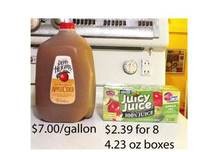Can A Unit Rate Be Used To Compare Two Rates? Absolutely! Understanding and applying unit rates is crucial for making informed decisions, whether you’re a student tackling math problems or a consumer comparing prices. COMPARE.EDU.VN is here to illuminate the path to mastering unit rate comparisons and unlocking their practical applications. This article explains how unit rates help in rate comparison and provides various real-world examples. Explore the relationship between ratios and rates, and understand comparative pricing for better purchasing decisions.
1. Understanding Unit Rates: The Foundation of Comparison
A unit rate expresses a ratio as a quantity of one. This “quantity of one” makes comparing different rates straightforward. For example, instead of comparing the cost of 10 apples to 15 oranges, you compare the cost per apple to the cost per orange. This standardization allows for an “apples to apples” comparison.
1.1. Defining Unit Rate
A unit rate is a ratio where the denominator is one. It tells you how much of one quantity you get for a single unit of another quantity.
- Examples: Miles per hour (mph), price per item, words per minute.
1.2. Calculating Unit Rates
To calculate a unit rate, divide the numerator of the rate by the denominator.
- Formula: Unit Rate = Quantity / Unit
- Example: If you drive 300 miles in 6 hours, your unit rate (speed) is 300 miles / 6 hours = 50 miles per hour.
1.3. The Significance of Unit Rates in Comparisons
Unit rates provide a common ground for comparing different rates, regardless of their original units or quantities. By converting rates to unit rates, you can quickly identify the better deal, the faster speed, or the more efficient process.
2. Why Use Unit Rates for Comparison?
Using unit rates for comparison simplifies decision-making by providing a standardized measure. It eliminates the confusion that can arise when dealing with different quantities and units.
2.1. Simplifying Complex Comparisons
When faced with complex scenarios involving different quantities, unit rates break down the information into manageable pieces.
- Scenario: Comparing the fuel efficiency of two cars.
- Car A: Travels 400 miles on 10 gallons of gas.
- Car B: Travels 360 miles on 9 gallons of gas.
- Unit Rate:
- Car A: 400 miles / 10 gallons = 40 miles per gallon.
- Car B: 360 miles / 9 gallons = 40 miles per gallon.
- Conclusion: Both cars have the same fuel efficiency.
2.2. Making Informed Decisions
Unit rates empower you to make informed decisions by providing a clear understanding of the value you are receiving.
- Example: Choosing between two job offers based on salary.
- Offer 1: $60,000 per year.
- Offer 2: $3,000 per month.
- Unit Rate:
- Offer 1: $60,000 / 12 months = $5,000 per month.
- Conclusion: Offer 1 is better as it provides a higher monthly income.
2.3. Identifying the Best Value
In purchasing decisions, unit rates help you identify the best value by comparing the cost per unit of different products.
- Example: Comparing the price of cereal.
- Box A: 10 ounces for $3.00.
- Box B: 15 ounces for $4.00.
- Unit Rate:
- Box A: $3.00 / 10 ounces = $0.30 per ounce.
- Box B: $4.00 / 15 ounces = $0.27 per ounce.
- Conclusion: Box B offers better value as it costs less per ounce.
3. Real-World Applications of Unit Rate Comparisons
Unit rate comparisons are used in various real-world scenarios, from grocery shopping to financial planning.
3.1. Grocery Shopping
Comparing prices of different brands or sizes of the same product using unit rates ensures you get the most for your money.
- Scenario: Comparing the price of two different sizes of peanut butter.
 Comparing the price of different sizes of peanut butter
Comparing the price of different sizes of peanut butter
* Jar A: 16 ounces for $4.80.
* Jar B: 28 ounces for $7.56.
* **Unit Rate:**
* Jar A: $4.80 / 16 ounces = $0.30 per ounce.
* Jar B: $7.56 / 28 ounces = $0.27 per ounce.
* **Conclusion:** Jar B is the better deal.3.2. Fuel Efficiency
Calculating and comparing the miles per gallon (MPG) of different vehicles helps in choosing a fuel-efficient option.
- Scenario: Comparing the fuel efficiency of two cars.
- Car X: Travels 350 miles on 14 gallons of gas.
- Car Y: Travels 420 miles on 15 gallons of gas.
- Unit Rate:
- Car X: 350 miles / 14 gallons = 25 miles per gallon.
- Car Y: 420 miles / 15 gallons = 28 miles per gallon.
- Conclusion: Car Y is more fuel-efficient.
3.3. Salary Comparisons
Comparing salaries based on hourly rates or monthly earnings provides a clear picture of earning potential.
- Scenario: Comparing two job offers.
- Job A: $50,000 per year.
- Job B: $2,600 per month.
- Unit Rate:
- Job A: $50,000 / 12 months = $4,166.67 per month.
- Conclusion: Job A offers a higher monthly salary.
3.4. Sports and Performance Metrics
In sports, unit rates are used to compare player performance, such as points per game, yards per carry, or goals per match.
- Scenario: Comparing the scoring ability of two basketball players.
- Player A: Scored 250 points in 10 games.
- Player B: Scored 300 points in 12 games.
- Unit Rate:
- Player A: 250 points / 10 games = 25 points per game.
- Player B: 300 points / 12 games = 25 points per game.
- Conclusion: Both players have the same scoring rate.
4. Unit Rates vs. Other Types of Rates
Understanding the difference between unit rates and other types of rates is crucial for accurate comparisons.
4.1. Distinguishing Unit Rates from General Rates
A general rate compares two quantities with different units, while a unit rate simplifies this comparison by expressing one quantity in terms of a single unit of the other.
- General Rate: 300 miles in 6 hours.
- Unit Rate: 50 miles per hour.
4.2. Ratios vs. Rates
A ratio compares two quantities, while a rate is a special type of ratio that compares quantities with different units.
- Ratio: 3 apples to 5 oranges (both are fruits).
- Rate: 60 miles per hour (miles and hours are different units).
4.3. Proportions and Unit Rates
Proportions can be used to find unit rates by setting up equivalent ratios.
- Example: If 2 apples cost $1.00, how much does 1 apple cost?
- Proportion: 2 apples / $1.00 = 1 apple / x
- Solving for x: x = $0.50 per apple (unit rate).
5. Advanced Techniques for Unit Rate Comparisons
Beyond basic calculations, advanced techniques can enhance the accuracy and usefulness of unit rate comparisons.
5.1. Handling Different Units of Measurement
When comparing rates with different units, conversion factors are necessary to standardize the measurements.
- Scenario: Comparing the speed of two runners.
- Runner A: Runs 100 meters in 12 seconds.
- Runner B: Runs 400 feet in 15 seconds.
- Conversion: 1 meter = 3.281 feet.
- Runner A: 100 meters * 3.281 feet/meter = 328.1 feet in 12 seconds.
- Unit Rate:
- Runner A: 328.1 feet / 12 seconds = 27.34 feet per second.
- Runner B: 400 feet / 15 seconds = 26.67 feet per second.
- Conclusion: Runner A is slightly faster.
5.2. Using Weighted Averages
Weighted averages are useful when comparing rates that have different levels of importance or frequency.
- Scenario: Comparing the gas mileage of a car in city and highway driving.
- City: 20 MPG (40% of driving).
- Highway: 30 MPG (60% of driving).
- Weighted Average: (0.40 20 MPG) + (0.60 30 MPG) = 8 MPG + 18 MPG = 26 MPG.
- Conclusion: The car’s average gas mileage is 26 MPG.
5.3. Incorporating Additional Factors
Consider additional factors that may influence the comparison, such as quality, durability, or hidden costs.
- Scenario: Comparing two printers based on price per page.
- Printer A: $0.05 per page, but requires frequent maintenance.
- Printer B: $0.07 per page, but is more reliable.
- Consideration: The cost of maintenance for Printer A may offset the lower price per page, making Printer B the better long-term investment.
6. Tools and Resources for Calculating Unit Rates
Various tools and resources are available to simplify the process of calculating and comparing unit rates.
6.1. Online Calculators
Online unit rate calculators can quickly convert rates into unit rates and compare them.
- Example: Entering “300 miles in 6 hours” into a unit rate calculator will instantly display the unit rate of 50 miles per hour.
6.2. Spreadsheet Software
Spreadsheet software like Microsoft Excel or Google Sheets can be used to create custom unit rate calculators and perform complex comparisons.
- Steps:
- Enter the quantities and units in separate columns.
- Create a formula to calculate the unit rate (e.g., =A2/B2).
- Compare the unit rates to make a decision.
6.3. Mobile Apps
Mobile apps designed for unit conversion and comparison are convenient for on-the-go decision-making.
- Features: Unit conversion, rate calculation, price comparison.
7. Common Mistakes to Avoid When Comparing Rates
Avoiding common mistakes ensures accurate and reliable rate comparisons.
7.1. Ignoring Units
Failing to pay attention to units can lead to incorrect comparisons.
- Example: Comparing miles per hour to kilometers per hour without converting to a common unit.
7.2. Not Converting to Unit Rates
Comparing rates directly without converting to unit rates can be misleading.
- Example: Assuming that 5 apples for $2.00 is a better deal than 8 apples for $3.00 without calculating the price per apple.
7.3. Overlooking Hidden Costs
Failing to consider hidden costs or additional factors can result in poor decisions.
- Example: Choosing a cheaper product that requires frequent replacements or repairs.
8. Case Studies: Unit Rate Comparisons in Action
Examining real-world case studies demonstrates the practical applications of unit rate comparisons.
8.1. Comparing Energy Providers
A homeowner uses unit rates to compare electricity providers and chooses the one with the lowest cost per kilowatt-hour (kWh).
- Scenario:
- Provider A: $0.12 per kWh.
- Provider B: $0.15 per kWh.
- Conclusion: Provider A offers a better rate.
8.2. Choosing a Mobile Data Plan
A student compares mobile data plans based on the cost per gigabyte (GB) and selects the most affordable option.
- Scenario:
- Plan X: $30 for 10 GB ($3 per GB).
- Plan Y: $40 for 15 GB ($2.67 per GB).
- Conclusion: Plan Y is more cost-effective.
8.3. Selecting a Loan
A business owner compares loan options based on the annual percentage rate (APR) and chooses the one with the lowest interest rate.
- Scenario:
- Loan A: 5% APR.
- Loan B: 6% APR.
- Conclusion: Loan A has a lower interest rate and is the better option.
9. The Role of COMPARE.EDU.VN in Facilitating Comparisons
COMPARE.EDU.VN provides a platform for users to compare a wide range of products, services, and ideas, making informed decisions easier than ever.
9.1. Providing Comprehensive Comparisons
COMPARE.EDU.VN offers detailed comparisons that highlight the pros and cons of each option, empowering users to make well-informed choices.
9.2. User Reviews and Ratings
Real user reviews and ratings provide valuable insights into the experiences of others, helping users assess the quality and reliability of different options.
9.3. Simplifying the Decision-Making Process
COMPARE.EDU.VN streamlines the decision-making process by presenting information in a clear and concise manner, making it easy for users to find the best option for their needs.
10. Future Trends in Rate Comparisons
The future of rate comparisons will likely involve more sophisticated tools and techniques, driven by advancements in technology and data analytics.
10.1. AI-Powered Comparison Tools
Artificial intelligence (AI) can analyze vast amounts of data to provide personalized recommendations and identify the best options based on individual preferences and needs.
10.2. Real-Time Rate Updates
Real-time rate updates will ensure that users have access to the most current information, enabling them to make timely decisions.
10.3. Predictive Analytics
Predictive analytics can forecast future trends and help users anticipate changes in rates, allowing them to plan accordingly.
FAQ: Understanding Unit Rate Comparisons
Q1: What is a unit rate?
A unit rate is a ratio where the denominator is one, expressing the quantity of one item per single unit of another.
Q2: Why are unit rates important for comparisons?
Unit rates standardize comparisons, making it easier to identify the best value or efficiency regardless of original units or quantities.
Q3: How do you calculate a unit rate?
Divide the numerator of the rate by the denominator to find the unit rate.
Q4: Can you give an example of using unit rates in grocery shopping?
Comparing the price per ounce of different sizes of the same product to determine which offers better value.
Q5: How are unit rates used in fuel efficiency comparisons?
By calculating miles per gallon (MPG) for different vehicles to determine which is more fuel-efficient.
Q6: What is the difference between a rate and a ratio?
A rate compares quantities with different units, while a ratio compares quantities with the same units.
Q7: What is a common mistake to avoid when comparing rates?
Ignoring the units can lead to incorrect comparisons.
Q8: How can COMPARE.EDU.VN help with making comparisons?
COMPARE.EDU.VN provides comprehensive comparisons, user reviews, and a simplified decision-making process to help users find the best options.
Q9: What is the role of weighted averages in unit rate comparisons?
Weighted averages are useful when comparing rates that have different levels of importance or frequency.
Q10: What are some future trends in rate comparisons?
AI-powered comparison tools, real-time rate updates, and predictive analytics.
Conclusion: Empowering Decisions with Unit Rate Comparisons
Mastering unit rate comparisons is essential for making informed decisions in various aspects of life. By understanding the principles and techniques discussed in this article, you can confidently evaluate options and choose the best value for your needs. Don’t let complex comparisons overwhelm you. Visit COMPARE.EDU.VN at 333 Comparison Plaza, Choice City, CA 90210, United States, or contact us via Whatsapp at +1 (626) 555-9090, and let our comprehensive comparisons guide you to smarter choices. Whether you’re comparing products, services, or ideas, compare.edu.vn is your trusted partner in simplifying the decision-making process.

